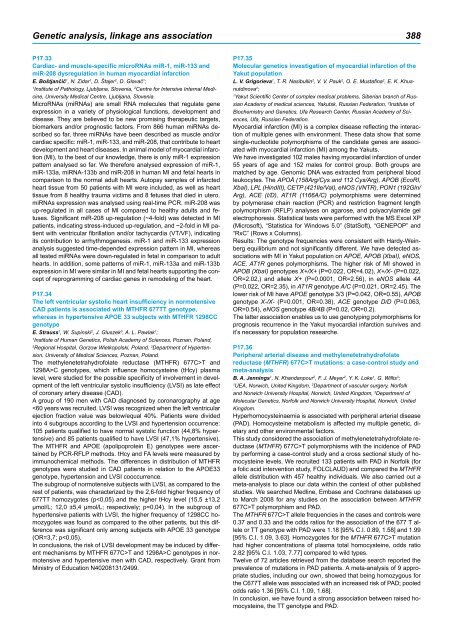2009 Vienna - European Society of Human Genetics
2009 Vienna - European Society of Human Genetics
2009 Vienna - European Society of Human Genetics
Create successful ePaper yourself
Turn your PDF publications into a flip-book with our unique Google optimized e-Paper software.
Genetic analysis, linkage ans association<br />
P17.33<br />
Cardiac- and muscle-specific microRNAs miR-1, miR-133 and<br />
miR-208 dysregulation in human myocardial infarction<br />
E. Boštjančič1 , N. Zidar1 , D. Štajer2 , D. Glavač1 ;<br />
1 2 Institute <strong>of</strong> Pathology, Ljubljana, Slovenia, Centre for Intensive Internal Medicine,<br />
University Medical Centre, Ljubljana, Slovenia.<br />
MicroRNAs (miRNAs) are small RNA molecules that regulate gene<br />
expression in a variety <strong>of</strong> physiological functions, development and<br />
disease. They are believed to be new promising therapeutic targets,<br />
biomarkers and/or prognostic factors. From 866 human miRNAs described<br />
so far, three miRNAs have been described as muscle and/or<br />
cardiac specific: miR-1, miR-133, and miR-208, that contribute to heart<br />
development and heart diseases. In animal model <strong>of</strong> myocardial infarction<br />
(MI), to the best <strong>of</strong> our knowledge, there is only miR-1 expression<br />
pattern analysed so far. We therefore analysed expression <strong>of</strong> miR-1,<br />
miR-133a, miRNA-133b and miR-208 in human MI and fetal hearts in<br />
comparison to the normal adult hearts. Autopsy samples <strong>of</strong> infarcted<br />
heart tissue from 50 patients with MI were included, as well as heart<br />
tissue from 8 healthy trauma victims and 8 fetuses that died in utero.<br />
miRNAs expression was analysed using real-time PCR. miR-208 was<br />
up-regulated in all cases <strong>of</strong> MI compared to healthy adults and fetuses.<br />
Significant miR-208 up-regulation (~4-fold) was detected in MI<br />
patients, indicating stress-induced up-regulation, and ~2-fold in MI patient<br />
with ventricular fibrillation and/or tachycardia (VT/VF), indicating<br />
its contribution to arrhythmogenesis. miR-1 and miR-133 expression<br />
analysis suggested time-depended expression pattern in MI, whereas<br />
all tested miRNAs were down-regulated in fetal in comparison to adult<br />
hearts. In addition, some patterns <strong>of</strong> miR-1, miR-133a and miR-133b<br />
expression in MI were similar in MI and fetal hearts supporting the concept<br />
<strong>of</strong> reprogramming <strong>of</strong> cardiac genes in remodeling <strong>of</strong> the heart.<br />
P17.34<br />
The left ventricular systolic heart insufficiency in normotensive<br />
cAD patients is associated with mtHFR 677tt genotype,<br />
whereas in hypertensive APOE 33 subjects with mtHFR 1298cc<br />
genotype<br />
E. Strauss1 , W. Supinski2 , J. Gluszek3 , A. L. Pawlak1 ;<br />
1Institute <strong>of</strong> <strong>Human</strong> <strong>Genetics</strong>, Polish Academy <strong>of</strong> Sciences, Poznan, Poland,<br />
2 3 Regional Hospital, Gorzow Wielkopolski, Poland, Department <strong>of</strong> Hypertension,<br />
University <strong>of</strong> Medical Sciences, Poznan, Poland.<br />
The methylenetetrahydr<strong>of</strong>olate reductase (MTHFR) 677C>T and<br />
1298A>C genotypes, which influence homocysteine (tHcy) plasma<br />
level, were studied for the possible specificity <strong>of</strong> involvement in development<br />
<strong>of</strong> the left ventricular systolic insufficiency (LVSI) as late effect<br />
<strong>of</strong> coronary artery disease (CAD).<br />
A group <strong>of</strong> 190 men with CAD diagnosed by coronarography at age<br />
t mutations: a case-control study and<br />
meta-analysis<br />
B. A. Jennings 1 , N. Khandanpour 2 , F. J. Meyer 2 , Y. K. Loke 1 , G. Willis 3 ;<br />
1 UEA, Norwich, United Kingdom, 2 Department <strong>of</strong> vascular surgery, Norfolk<br />
and Norwich University Hospital, Norwich, United Kingdom, 3 Department <strong>of</strong><br />
Molecular <strong>Genetics</strong>, Norfolk and Norwich University Hospital, Norwich, United<br />
Kingdom.<br />
Hyperhomocysteinaemia is associated with peripheral arterial disease<br />
(PAD). Homocysteine metabolism is affected my multiple genetic, dietary<br />
and other environmental factors.<br />
This study considered the association <strong>of</strong> methylenetetrahydr<strong>of</strong>olate reductase<br />
(MTHFR) 677C>T polymorphisms with the incidence <strong>of</strong> PAD<br />
by performing a case-control study and a cross sectional study <strong>of</strong> homocysteine<br />
levels. We recruited 133 patients with PAD in Norfolk (for<br />
a folic acid intervention study, FOLCLAUD) and compared the MTHFR<br />
allele distribution with 457 healthy individuals. We also carried out a<br />
meta-analysis to place our data within the context <strong>of</strong> other published<br />
studies. We searched Medline, Embase and Cochrane databases up<br />
to March 2008 for any studies on the association between MTHFR<br />
677C>T polymorphism and PAD.<br />
The MTHFR 677C>T allele frequencies in the cases and controls were<br />
0.37 and 0.33 and the odds ratios for the association <strong>of</strong> the 677 T allele<br />
or TT genotype with PAD were 1.18 [95% C.I. 0.89, 1.58] and 1.99<br />
[95% C.I. 1.09, 3.63]. Homozygotes for the MTHFR 677C>T mutation<br />
had higher concentrations <strong>of</strong> plasma total homocysteine, odds ratio<br />
2.82 [95% C.I. 1.03, 7.77] compared to wild types.<br />
Twelve <strong>of</strong> 72 articles retrieved from the database search reported the<br />
prevalence <strong>of</strong> mutations in PAD patients. A meta-analysis <strong>of</strong> 9 appropriate<br />
studies, including our own, showed that being homozygous for<br />
the C677T allele was associated with an increased risk <strong>of</strong> PAD; pooled<br />
odds ratio 1.36 [95% C.I. 1.09, 1.68].<br />
In conclusion, we have found a strong association between raised homocysteine,<br />
the TT genotype and PAD.

















